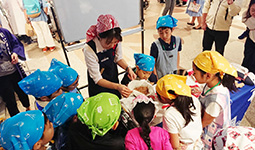Home > Highlighting JAPAN > Highlighting Japan November 2019 > Japan’s Food Culture
Highlighting JAPAN


Dashi: The Foundation of Traditional Japanese Food
Umami-rich dashi stock brings out the flavor of washoku, traditional Japanese food.
The human tongue can identify five basic tastes—sweetness, sourness, saltiness, bitterness and umami. Of these, umami was discovered and named by Dr. Ikeda Kikunae at the Tokyo Imperial University in 1908. But people had long possessed the empirical knowledge that umami made food tastier, and meat, fish and vegetables that include components of umami, such as glutamic acid and inosinic acid, have traditionally been used to create bouillon broth in Western food, gao tang stock in Chinese food and dashi stock in washoku (traditional Japanese food).
“Dashi can be said to constitute the foundation of Japanese food,” says Takatsu Katsuyuki, President of Ninben. “It can improve the flavor of a dish’s ingredients, with dashi derived from katsuobushi having among other things a rich aroma.” Ninben was founded in Nihonbashi, Tokyo in 1699, and is one of Japan’s representative longevity companies. Since its establishment, the company has engaged mainly in the manufacture and retail of katsuobushi.
Katsuobushi is dried, fermented and smoked katsuo (skipjack tuna). Dashi can be derived from it in the form of kezuribushi, which are flakes shaved from the katsuobushi block. The thickness of the kezuribushi flakes used in dashi depends on what is being made.
Katsuo are abundant in Japanese coastal waters and have long been a source of protein for Japanese people. It was in the Edo period (1603–1867) that katsuobushi began to be used widely as an ingredient for dashi. In the early Edo period, the manufacturing method of boiling, smoking and drying katsuo to make katsuobushi was established, and it remains largely unchanged today. In the late Edo period, a method of increasing umami by repeatedly drying and applying mold to the surface of the katsuobushi was developed.
Besides katsuobushi, in the Edo period kombu kelp gathered in Hokkaido was carried to Osaka, a commercial city often called the “Nation’s Kitchen,” by the Kitamae-bune ships traveling the Sea of Japan, leading to its spread as another ingredient for dashi. However, katsuobushi and kombu were so expensive that ordinary people began to use another ingredient to make dashi, niboshi, which are dried small fish such as sardines.
Soon other seasonings such as miso and soy sauce began to be mass-produced in the suburbs of cities like Edo (now Tokyo) and Japanese food culture developed rapidly. Typical Japanese dishes such as soba noodles and tempura came to be eaten widely.
“It is considered that a combination of seasonings, such as miso, soy sauce and dashi, led to the creation of today’s familiar soba and tempura sauces,” says Takatsu. “Dashi made from a combination of katsuobushi and kombu also came to be used in cooking. Umami can be greatly strengthened by the synergetic effects produced by two types of dashi.”
In and after the Edo period, dashi became the basis of Japanese food culture. In recent years, dashi has attracted renewed attention amid the spread of Japanese dishes to foreign countries and the inscription of washoku on UNESCO’s Representative List of the Intangible Cultural Heritage of Humanity.
As a part of its shokuiku (food and nutrition education) activities, Ninben teaches washoku and dashi culture using katsuobushi in educational institutions and at events across the country. Today, premixed liquid and powdered dashi derived from katsuobushi and kombu are often used in Japanese home cooking. In the past, however, home cooks shaved their own block of katsuobushi using a kezuriki (shaver) to make dashi. In Ninben Shokuiku classes, participants learn how to shave katsuobushi using a kezuriki and make dashi, and often express surprise at the rich aroma of katsuobushi and the quality of the dashi produced from it, Takatsu says.
Goods including katsuobushi are sold at the Ninben Nihonbashi Honten, which opened at COREDO Muromachi in 2010, and shaving of katsuobushi is demonstrated at the store. The Nihonbashi Dashi Bar at the Honten also sells foods such as Dashi Soup using dashi made from katsuobushi, and katsubushi-meshi, rice topped with freshly shaved katsuobushi. At lunchtime, many neighborhood office workers and shoppers visit the store.
“We never expected that dashi freshly made from katsuobushi would become so popular,” says Takatsu. “We will prepare even more places where people can come to know the charms of dashi and enjoy tasting it.”
© 2009 Cabinet Office, Government of Japan








